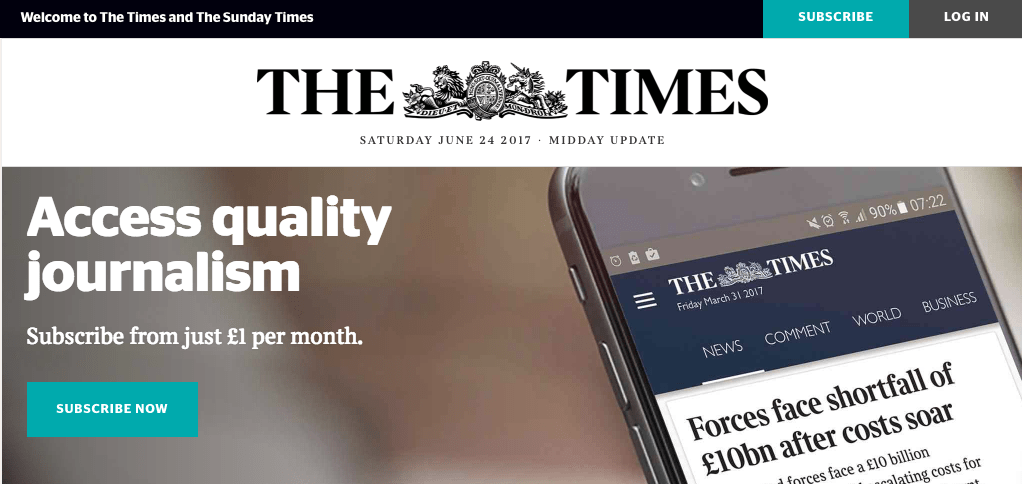For a number of years, websites that keep their primary (main) content behind paywalls have had mixed results with organic search. A lot of SEOs and business owners, however, forget that Google isn’t just about keywords, backlinks, and technical structure; it’s about providing a gratifying search experience for the user.
There have been case studies recently of major newspaper websites taking a u-turn on their decisions to move behind paywalls because of the negative impact it had on their search performance.
Google has no interest in sending users to a website where the content (that satisfies their query intent) is behind a pay gateway. It’s a poor user experience, especially if the same (or similar) content is provided by other websites. It is worth saying now that this isn’t true for all instances, but they are often brands who have built up a strong presence (and the necessary offsite signals relevant to SEO).
The Paid Content Problem
Google has publicly said that strict paywalls pose problems as they want to provide the user with a positive search experience. There are two models to premium content: the total paywall as demonstrated by the Times of London, and the leaky model utilized by the New York Times.

In comparison, the New York Times has four times the organic search visibility in the United Kingdom than the Times of London (based on SEMrush data), which, based on their geographical location, is counterintuitive.
The reason behind this is that the New York Times offers free content as well as premium, allowing users from organic search and social media to sample a substantial amount of their high-quality content for free.
Post Excerpts for Free Users
A lot of people tend to forget that Google’s main objective is user experience. A lot of premium content websites provide excerpts and snippets to free users, which is fine if your competition is also doing the same. But if they’re offering a lot more then you need to do so as well.
When Google assesses a page’s content, it looks for both main content and supplemental content. We know from the Fred update and research conducted by Glenn Gabe that websites focusing on monetization (rather than user value) saw an impact on rankings.
First Click Free
Google introduced First Click Free so that users coming from organic search could see an article, usually behind a paywall, for free and then subsequent clicks onsite to other articles and pieces of content trigger the paywall.
A lot of publishers dislike the idea, as subscription based news/magazine content was seen as the online savior to declining print circulations. Google originally limited a user to five free clicks per day, but this has since become three due to publisher pushback.
Balancing Free Content & Premium Content
As proven by the New York Times (and others), having a good balance of free content as well as your premium content offering can and will help you perform in organic search.
This isn’t free content that leads users down a funnel to becoming a paid member, but content that satisfies the user query and provides value. This value is what Google is wanting to see, and ultimately what it ranks within its search results.
A counter argument to this strategy is that it will create a segment of users who return to the website to only consume free content, and will never convert into premium members.
But is this really an issue?
Sure, you could feel that you’re giving away a lot of your content for free, but in doing so you’re bringing in more traffic to the website and potentially ranking alongside other websites offering the same type of content as you (but for free).
Looking at it from Google’s perspective, what would you prefer to see appearing in search results: a lot of small excerpts and snippets, or full articles and content pieces?
Free Articles & Collecting User Data
One of the biggest subscription/premium content websites online is The Economist. Over the years they have tinkered and amended their premium content/free content balance and it’s been reported that at one stage up to 15 percent of the website’s content was available for free.
The approach currently taken by the publisher is to allow a number of free articles to users each week, with further free access granted should a user subscribe to marketing newsletters.
If you produce a substantial amount of content, this is a great approach as you’ll never give away a big enough percentage of your content to devalue your overall product. But what if you only produce one or two new pieces of content a week (or less)?
User-Generated Content
If you don’t want to give away the content that you’ve paid to produce, or you don’t have the ability to produce both free and premium content in good volumes, user-generated content (UGC) is the perfect solution. UGC is also great even if you don’t operate a premium content website.
User Contributions
Community blogs aren’t a new idea, but they often go overlooked. Yes, there will be a need to moderate the content for quality, suitability, and potentially spammy and unnatural links, but it’s a small price to pay.
This tactic has been employed by premium content websites in all verticals, ranging from recipes and fan fiction to marketing and the adult sector.
Community Forums
A great example of this is the Vanish Tip Exchange. Vanish is a Reckitt Benckiser consumer brand, and started the Tip Exchange in 2013.
Creating a user forum where product users can exchange tips and tricks and provide advice based on their own experiences has given the Vanish website a naturally occurring Q&A section, as well as naturally included a lot of long-tail search queries.
The only caveat to the forum/community approach is that it needs to be active to remain relevant and valuable. The Tip Exchange doesn’t appear to have been updated since April 2016.
Conclusion
If you’re up against competitors that don’t use paywalls and your content is effectively the same (recipes, videos, fiction stories), then you’re not going to have a good time of things in terms of organic search. Unless you’ve built up such gravitas as a brand, it doesn’t matter.
Google is constantly updating its algorithms, and this isn’t always in the form of an announced update. I’ve personally seen search engine results change based on real-world news and events, and search terms bring up totally different results than they did previously.
If your business model relies on subscriptions and premium memberships, it’s imperative that you offer free content (which can be user generated) to provide value that both the user and Google will appreciate.
Images Credits
Screenshot by author. Taken June 2017.




